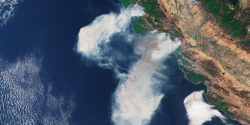The local service of radio grows enormously in value when disaster strikes a community. This is what we’ve seen with the wildfires that have swept through the Northern California counties of Napa, Sonoma, Mendocino, Lake and Solano beginning last week. Fast moving and unpredictable, these deadly fires also took out communications infrastructure like cell towers, internet and cable TV, leaving radio as one of the most reliable sources of potentially life-saving information.
Commercial and non-commercial stations stepped up to offer emergency information to residents and first responders. Large Bay Area stations offered coverage, but often it was smaller, locally-owned stations that could better serve the hyper-local information needs, able to report the conditions on the ground in specific towns, cities and neighborhoods, from what roads are shut down, to what kind of donations were most in need at specific emergency shelters.
My San Francisco-based colleague Jennifer Waits reported hearing an emergency services press conference on “Sauvignon Rock” station KVYN-FM The Vine in Napa, which also ran a bilingual call-in show where residents could get answers regarding local emergency services. In addition emergency information was broadcast on Sonoma Community Radio KSVY and country station KZST in Sonoma.
The Willits News in Mendocino County documented the service that LPFM KLLG provided the community:
“Michelle Cummins, program manager at KLLG radio said people were coming up to her at Mariposa Market last week thanking her for the fledging station’s crucial role during the fire emergencies.
“When cell phone towers were damaged and all cell phone communications (with the exception of satellite phones), and internet were unavailable over a two day period as a result of the Mendocino Lake Complex fire, KLLG and KZYX Public radio became the local sources of information in Willits.”
Inside Radio talked with staff of two small commercial radio groups in the area, Wine Down Media and Redwood Empire Stereocasters (owner of KZST), which switched their stations’ music programming to “wall-to-wall coverage.” Staff at Redwood Empire studios even had to evacuate twice due to the fire threat, only to return when the flames receded. Owner Gordon Zlot recounted the story to public radio KALW in San Francisco.
Radio newsletter Tom Taylor Now published a report from the Sonoma Media Group, owner of six stations, including news/talk KSRO. Market manager Michael O’Shea said the latter station ran, “24/7 commercial-free news coverage for 72 straight hours, with virtually all the group’s on-air people helping the news anchors with coverage, handling phones, feeding social media, etc.” The coverage was noticed and appreciated. “I can’t tell you how many times listeners would call and tell us this same discovery,” he said. “[T]hey almost had to re-learn the ultimate magic of local live radio.”
Amateur radio operators also reported for duty, as they do during nearly every kind of disaster, natural or man-made. According to the American Radio Relay League ham radio operators were stationed at local hospitals and large nursing homes through the middle of last week in Mendocino County. In Sonoma County amateur operators were relaying fire and emergency information on amateur radio frequencies, and also supporting shelters and maintaining a presence at the area Emergency Operations Center.
This celebration of local radio isn’t at the expense of other media platforms. Most of these stations maintained a strong presence on social media, providing updates along with live feeds from regular press briefings by local authorities whenever possible. Moreover, some stations had to rely only on their internet streams and social media when their transmitters were knocked off air by the fire.
And, while internet and cell was out in some areas, this wasn’t the case everywhere. What this means is that radio is part of a fabric of media and communications, where each platform has its particular strengths and can be called to serve when and where other platforms are less appropriate, or unavailable.
What makes the difference are the people who step up to do the work, to broadcast information and create that lifeline when needed. One advantage that a radio station has is that community trust – the standing of being a community asset that folks trust due to a record of service. You might say that a local radio station is authenticated – you know (in most cases) that they’re working hard to be accurate and reliable in their service, especially in trying times.
With so many media and audio options available to us, it’s understandable if you don’t tune in to local radio every day. But don’t forget about your local stations, either. Because it’s all too likely that there will be a day when you need them, and tuning in will be vitally important.
Additional reporting and contributions by Jennifer Waits



